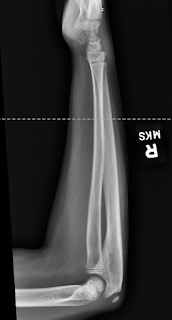The elbow is not commonly discussed around the topic of birth differences of the upper extremity. We discuss fingers, wrist, and forearm most commonly. The shoulder is also occasionally involved but much less so compared even to the elbow. My goal in this blog post is to highlight some of the birth differences that may include elbow involvement. This post is not meant to be a comprehensive discussion of each of these many topics (rather, see the many other posts on these topics).
The elbow is made up of the three joints:
1) the ulnohumeral joint which allows flexion and extension (bending and straightening).
2) the radiocapitellar joint which helps with forearm rotation.
3) the proximal radioulnar joint also helps with forearm rotation
These conditions can interrupt normal function of any one of these joints.
1) Radial longitudinal deficiency (RLD) does not truly affect the elbow as the ulnohumeral joint is normal. However, when the radius is completely absent (type 4 or 5) it does affect the forearm (absent rotation).
 |
| RLD with absent radius bone. The ulna is relatively normal (slightly short). The hand and wrist are clearly affected. |
2) Ulnar longitudinal deficiency (ULD) affects the elbow joint through the ulnohumeral joint. Without a normal ulnohumeral joint, elbow flexion and extension may be limited. In addition, there can be fusion (or joining) of the radius to the humerus which prevents any movement of the elbow joint at all. And finally, depending on the exact issues, the radial head may be dislocated.
 |
| ULD showing a short ulna and a curved radius bone with a dislocation of the radial head. |
3) Radial head dislocation occurs when the radial head does not line up with the capitellum. While this can be related to trauma, often it is related to a birth difference. Sometimes this has a minimal effect on function but sometimes forearm and elbow motion may be limited.
 |
| Patient with dislocation of the radial head (it is sitting too high in the picture). |
 |
| Normal forearm and elbow |
 |
| Synostosis of the radius and ulna. Note the bony bridge between the two forearm bones. |
5) Arthrogryposis affects the muscles in the upper extremity and, due to muscle stiffness, can also affect the joint mobility. The elbow is classically in a position of full extension (i.e., straight) which makes function difficult.
6) Transverse Deficiency/ symbrachydactyly occurs when there is an amputation at the proximal portion of the forearm. There may or may not be nubbins on the end of the forearm. The elbow may be normal but occasionally, and especially as kids get older, there can be grinding and discomfort in the elbow joint itself.
 |
| Forearm level amputation just past the elbow, symbrachydactyly with nubbins. |
 |
| Ulnar dimelia with two ulna bones and no radius. |
While there are many other birth differences that affect the elbow joint, these are the most common and the most notable. Please refer to other posts for more details.
email: congenitalhand@wustl.edu
Please CLICK HERE to support our research.
Designate my name. Thank you!
In the case of humeroradial synostosis, is there any treatment to restore function of the elbow? Additionally, if a patient with ULD has a shortened (but present) ulna and fusion of the humerus and radius, would they still be considered type 4? I am searching for information to better understand the prognosis for my newborn daughter. Thank you for any information you can provide.
Paige,
Congratulations on the birth of your daughter! There are options depending on how ‘normal’ the elbow joint is between the humerus and the ulna (ie, how developed the ulna is). On occasion, we will ‘take down’ the fusion between the radius and the humerus to allow the elbow to move. Email me at congenitalhand@wustl.edu if you would like to discuss further.
The classifications vary (there are a number of them) but the radiohumeral synostosis does guide classification (rather than the ulna development).